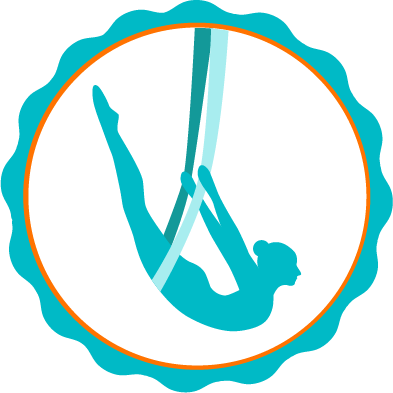Understanding the Difference Between Aerial Hammock, Aerial Silk, and Aerial Hoop
17 May, 2023
By Admin

Aerial arts have skyrocketed in popularity over the last decade, becoming a favourite among fitness enthusiasts, circus performers, and creative movers alike. These aerial disciplines offer a mix of strength, flexibility, and grace, and while they may seem similar at first glance, each one is distinct in terms of equipment, technique, and the type of experience they offer.
In this blog, we dive into the differences between Aerial Hammock, Aerial Silk, and Aerial Hoop, exploring how each discipline works and what makes them unique.
1. Aerial Hammock (also known as Aerial Sling)
What is it?
Aerial Hammock, or Aerial Sling, is a type of aerial apparatus that uses a single piece of fabric that’s rigged from a single point. The fabric is generally wider than the one used for Aerial Silks and is designed to provide a supportive "hammock-like" feel. It allows for a wide range of poses and movements, with the fabric often cradling or supporting the body in different positions.
What’s Unique About It?
- Supportive and Comfortable: The hammock shape is much more stable and comfortable than the silks, making it easier for beginners to learn and perform tricks. It’s often used for more relaxed, flowing movements, as well as supported poses.
- Variety of Movement: Aerial Hammock gives you more freedom to create fluid, suspended sequences without the need for the high level of technicality that’s often associated with Aerial Silks.
- Suspension: The fabric is rigged from one point, so the experience tends to be more stable, with less swinging and more control. This makes it an ideal option for people who want a less intimidating introduction to aerial arts.
Popular for:
- Yoga-inspired aerial sequences
- Beginners in aerial arts
- Artists seeking graceful, supported movements
2. Aerial Silks
What is it?
Aerial Silks, also known as aerial tissu or aerial fabric, involves two long pieces of fabric suspended from the ceiling, typically rigged from two points. Performers climb, wrap, twist, and drop in various acrobatic sequences, often combining strength, flexibility, and choreography. The silks are known for being challenging because they require considerable core strength and endurance.
What’s Unique About It?
- Two Fabrics, More Complex Moves: The two separate silks allow for more intricate climbing and wrapping techniques. Aerialists use both silks for support and to create complex wraps and knots that can transition into drops or poses.
- Challenging and Dynamic: Aerial Silks requires more strength and technique than Aerial Hammock. It’s known for its breath-taking drops, inversions, and the need for more control over the fabric.
- Flexibility and Acrobatics: The silks allow for dynamic, acrobatic movements, and performances often include high-flying drops and dramatic poses.
Popular for:
- Advanced aerial performances
- High-flying acrobatics
- Strength and conditioning routines
- Circus acts and live performances
3. Aerial Hoop (also known as Lyra)
What is it?
Aerial Hoop, or Lyra, is an apparatus that consists of a large, circular metal hoop suspended from a single point. Unlike fabric-based apparatuses, the hoop allows for dynamic, controlled movement in and around the ring. Performers use the hoop for various poses, spins, and acrobatic tricks, often using their hands, feet, or entire bodies to manoeuvre through the hoop.
What’s Unique About It?
- Circular and Structured: The hoop is a rigid structure, making it different from the flowing, flexible nature of fabric-based apparatuses. This stability allows for more precise movements and controlled spins.
- Gymnastic and Strength-based: Aerial Hoop is highly focused on strength, flexibility, and body control. Movements in the hoop often require full-body coordination, with the performer needing to hold themselves in positions or execute intricate spins.
- Spin and Rotation: The hoop can be made to spin in multiple directions, adding an extra dimension to performances. This spinning action can either be controlled or allowed to move freely, creating a fluid, circling motion that enhances visual appeal.
Popular for:
- Choreographed routines
- Strength and flexibility training
- Dynamic, rotational moves and poses
- Circus-style performances
So, What’s the Difference?
- Equipment:
- Aerial Hammock uses a single piece of fabric that supports the body, while Aerial Silks involves two pieces of fabric for climbing and wrapping.
- Aerial Hoop uses a metal hoop (Lyra), which provides a rigid structure for spins, poses, and aerial acrobatics.
- Movement Style:
- Aerial Hammock is typically focused on supported, graceful movements with less emphasis on strength and more on flow.
- Aerial Silks requires more intricate climbing and wrapping techniques, with a focus on acrobatic sequences, drops, and strength.
- Aerial Hoop emphasizes strength, control, and precision, with a unique focus on rotational movements and poses within the hoop.
- Difficulty:
- Aerial Hammock is often seen as more beginner-friendly due to the support it provides and its less complex movements.
- Aerial Silks tends to be more challenging, requiring strength, flexibility, and technical skill.
- Aerial Hoop demands a high level of body control and strength, particularly in the upper body and core.
- Appeal:
- Aerial Hammock is ideal for those seeking a supportive, flowing, and relaxing experience.
- Aerial Silks appeals to those interested in acrobatics, drops, and dynamic movements.
- Aerial Hoop is best for those who love rotational movement, gymnastic-style strength training, and precision in their aerial performance.
Conclusion
While Aerial Hammock, Aerial Silk, and Aerial Hoop each offer unique challenges and rewards, the best choice depends on your personal goals, skill level, and the type of aerial performance or workout you’re seeking. Whether you're looking for a graceful introduction to aerial arts, the thrill of acrobatic drops, or a full-body strength workout, each discipline has something special to offer.
So, why not give them all a try? You might just find yourself hooked on the magic of the aerial world! Have you tried one of these aerial arts yet? Which one appeals to you the most? Drop a comment below or share your experiences with us!
Tekrarlama Saati fake rolex replica watches replika saatler fake rolex replica watches
